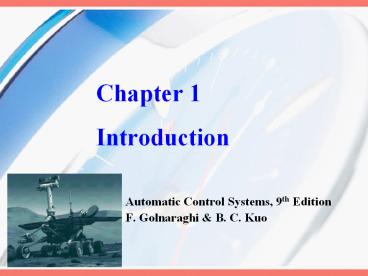Chapter 1 Introduction - PowerPoint PPT Presentation
1 / 22
Title:
Chapter 1 Introduction
Description:
Introduction Automatic Control Systems, 9th Edition F. Golnaraghi & B. C. Kuo 1-1 Introduction Main objectives of this chapter: To define a control system To explain ... – PowerPoint PPT presentation
Number of Views:224
Avg rating:3.0/5.0
Title: Chapter 1 Introduction
1
Chapter 1Introduction
- Automatic Control Systems, 9th Edition
- F. Golnaraghi B. C. Kuo
2
1-1 Introduction
1, p. 1
- Main objectives of this chapter
- To define a control system
- To explain why control systems are important
- To introduce the basic components of a control
systems - To give some examples of control-system
applications - To explain why feedback is incorporated into most
control systems - To introduce types of control systems
3
Basic Components of a Control System
1, p. 2
- Objectives inputs or actuating signals, u
- Results outputs or controlled variables, y
4
Examples of Control-System Applications
1, p. 4
- Idle-speed control of an automobile
- Eliminate or minimize the speed droop when engine
loading is applied - Maintain the engine idle speed at a desired value
5
Examples of Control-System Applications
1, pp. 4-5
- Sun-tracking control of solar collectors
6
Sun-Tracking Control System
1, p. 5
- Water extraction using solar power
7
Sun-Tracking Control System
1, p. 5
- Important components
8
Open-Loop Control Systems
1, p. 6
- Open-loop systems ? Nonfeedback systems
- The idle-speed control system shown in Fig. 1-2
is called an open-loop control systems.
9
Closed-Loop Control Systems
1, p. 7
- A system with one or more feedback paths is
called a closed-loop system. - Closed-loop control systems ? Feedback control
systems - Closed-loop systems have many advantages over
open-loop systems.
10
Responses of Idle-Speed Control Syst.
1, p. 7
- The objective of a regulator system is to
maintain the system at a prescribed level.
11
1-2 What Is Feedback, And What Are Its Effects?
2, p. 8
- Simple Feedback System Configuration
- Feedback exists whenever there is a closed
sequence of cause-and-effect relationships.
Error (e r ? Hb)
Output signal (y Ge)
Input signal
Constant gains
Feedback signal(b Hy)
12
Effect of Feedback on Overall Gain
2, p. 8
- Input-output relation
(1-1) - Feedback may increase the gain of a system in one
frequency range but decrease it in another.
13
Two Feedback Loops
2, p. 9
- Input-output relation
(1-2)
Inner loop
outer loop
14
Effect of Feedback on Stability (1/2)
2, p. 9
- A system is unstable if its output is out of
control. - Feedback can cause a system that is originally
stable to become unstable. - Example If GH ?1 in (1-1), the output of the
system is infinite for any finite input. - The system is said to be unstable.
15
Effect of Feedback on Stability (2/2)
2, p. 9
- Feedback can stabilize an unstable system.
- Example Assume that the inner-loop feedback
system in Fig. 1-10 is unstable (i.e., GH
?1).The overall system can be stable by properly
selecting the outer-loop feedback gain F. - Feedback can improve stability or be harmful to
stability if it is not properly applied.
16
Sensitivity
2, p. 10
- A good control system should be very insensitive
to parameter variations but sensitive to the
input commands. - Definition The sensitivity of the gain of the
overall system M to the variation in G - (1-3)
- Let . Then
- Feedback can increase or decrease the sensitivity
of a system.
(1-4)
17
Effect of Feedback onExternal Disturbance or
Noise
2, pp. 10-11
- Feedback can reduce the effect of noise and
disturbance on system performance. - The system output y due to the noise signal n
acting alone - In the absence of feedback (H0),
(1-5) - With the presence of feedback,
(1-6)
18
Effect of Feedback Summary
2, p. 11
- Feedback may increase the gain of a system in one
frequency range but decrease it in another. - Feedback can improve stability or be harmful to
stability if it is not properly applied. - Feedback can increase or decrease the sensitivity
of a system. - Feedback also can affect bandwidth, impedance,
transient responses, and frequency responses.
19
1-3 Types of Feedback Control Systems
3, p. 11
- According to the method of analysis and design
- linear or nonlinear
- time-varying or time-invariant
- According to the types of signal found in the
system - continuous-data or discrete-data
- modulated or unmodulated
- According to the main purpose of the system
- position-control or velocity-control
ac or dc control system
sampled-data or digital control system
20
AC Control System
3, pp. 12-13
- The signals in the system are modulated by some
form of modulation scheme.
21
DC Control System
3, p. 12-13
- The signals in the system are unmodulated, but
they are still ac signals according to the
conventional definition.
22
Sample-Data Digital Control Systems
3, p. 14































